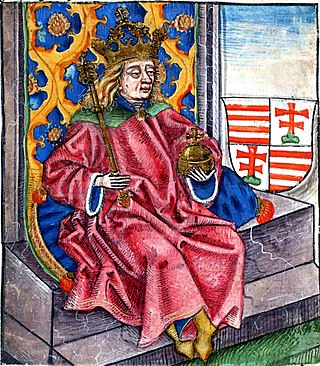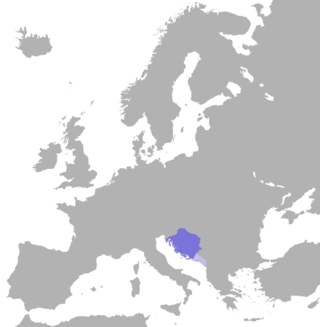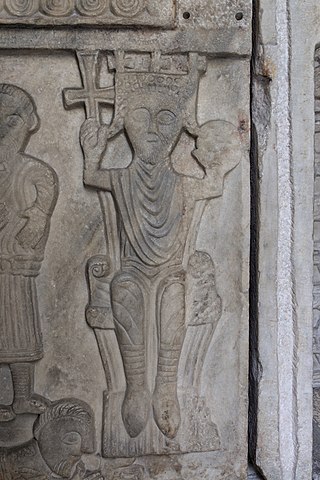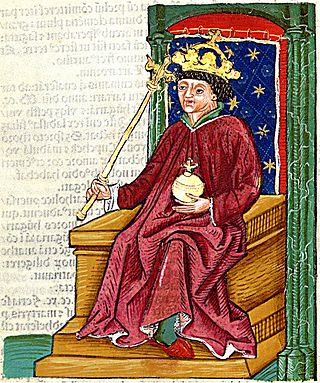Related Research Articles

Andrew II, also known as Andrew of Jerusalem, was King of Hungary and Croatia between 1205 and 1235. He ruled the Principality of Halych from 1188 until 1189/1190, and again between 1208/1209 and 1210. He was the younger son of Béla III of Hungary, who entrusted him with the administration of the newly conquered Principality of Halych in 1188. Andrew's rule was unpopular, and the boyars expelled him. Béla III willed property and money to Andrew, obliging him to lead a crusade to the Holy Land. Instead, Andrew forced his elder brother, King Emeric of Hungary, to cede Croatia and Dalmatia as an appanage to him in 1197. The following year, Andrew occupied Hum.

The Kingdom of Croatia entered a personal union with the Kingdom of Hungary in 1102, after a period of rule of kings from the Trpimirović and Svetoslavić dynasties and a succession crisis following the death of king Demetrius Zvonimir. With the coronation of King Coloman of Hungary as "King of Croatia and Dalmatia" in 1102 in Biograd, the realm passed to the Árpád dynasty until 1301, when the (male) line of the dynasty died out. Then, kings from the Capetian House of Anjou, who were also cognatic descendants of the Árpád kings, ruled the kingdoms. Later centuries were characterized by conflicts with the Mongols, who sacked Zagreb in 1242, competition with Venice for control over Dalmatian coastal cities, and internal warfare among Croatian nobility. Various individuals emerged during the period, such as Paul I Šubić of Bribir, who was representing the most powerful Croatian dynasty at the time, the Šubić noble family. These powerful individuals were on occasion able to de facto secure great deal of independence for their fiefdoms. The Ottoman incursion into Europe in the 16th century significantly reduced Croatian territories and left the country weak and divided. After the death of Louis II in 1526 during the Battle of Mohács and a brief period of dynastic dispute, both crowns passed to the Austrian House of Habsburg, and the realms became part of the Habsburg monarchy.

Béla IV was King of Hungary and Croatia between 1235 and 1270, and Duke of Styria from 1254 to 1258. As the oldest son of King Andrew II, he was crowned upon the initiative of a group of influential noblemen in his father's lifetime in 1214. His father, who strongly opposed Béla's coronation, refused to give him a province to rule until 1220. In this year, Béla was appointed Duke of Slavonia, also with jurisdiction in Croatia and Dalmatia. Around the same time, Béla married Maria, a daughter of Theodore I Laskaris, Emperor of Nicaea. From 1226, he governed Transylvania as duke. He supported Christian missions among the pagan Cumans who dwelled in the plains to the east of his province. Some Cuman chieftains acknowledged his suzerainty and he adopted the title of King of Cumania in 1233. King Andrew died on 21 September 1235 and Béla succeeded him. He attempted to restore royal authority, which had diminished under his father. For this purpose, he revised his predecessors' land grants and reclaimed former royal estates, causing discontent among the noblemen and the prelates.

The Kingdom of Croatia, or Croatian Kingdom, was a medieval kingdom in Southern Europe comprising most of what is today Croatia, as well as most of the modern-day Bosnia and Herzegovina. The Croatian Kingdom was ruled for part of its existence by ethnic dynasties, and the Kingdom existed as a sovereign state for nearly two centuries. Its existence was characterized by various conflicts and periods of peace or alliance with the Bulgarians, Byzantines, Hungarians, and competition with Venice for control over the eastern Adriatic coast. The goal of promoting the Croatian language in the religious service was initially introduced by the 10th century bishop Gregory of Nin, which resulted in a conflict with the Pope, later to be put down by him. In the second half of the 11th century Croatia managed to secure most coastal cities of Dalmatia with the collapse of Byzantine control over them. During this time the kingdom reached its peak under the rule of kings Peter Krešimir IV (1058–1074) and Demetrius Zvonimir (1075–1089).

The Kingdom of Croatia-Slavonia was a nominally autonomous kingdom and constitutionally defined separate political nation within the Austro-Hungarian Empire. It was created in 1868 by merging the kingdoms of Croatia and Slavonia following the Croatian–Hungarian Settlement of 1868. It was associated with the Kingdom of Hungary within the dual Austro-Hungarian state, being within the Lands of the Crown of St. Stephen, also known as Transleithania. While Croatia had been granted a wide internal autonomy with "national features", in reality, Croatian control over key issues such as tax and military issues was minimal and hampered by Hungary. It was internally officially referred to as the Triune Kingdom of Croatia, Slavonia and Dalmatia, also simply known as the Triune Kingdom, and had claims on Dalmatia, which was administered separately by the Austrian Cisleithania. The city of Rijeka, following a disputed section in the 1868 Settlement known as the Rijeka Addendum, became a corpus separatum and was legally owned by Hungary, but administered by both Croatia and Hungary.

Demetrius Zvonimir was a King of Croatia and Dalmatia from 1075 or 1076 until his death in 1089. Prior to that, Zvonimir also served as Ban of Croatia (1064/1070–1074). His native name was Zvonimir, but adopted the forename Demetrius at his coronation.

Hrvoje Vukčić Hrvatinić was a medieval Bosnian nobleman and magnate, Grand Duke of Bosnia, Knez of Donji Kraji, and Duke of Split. He was the most prominent member of the Hrvatinić noble family, and one of the major feudal lords in Kingdom of Bosnia. He was Grand Duke of Bosnia under three Bosnian kings: King Tvrtko I, King Stephen Dabiša and King Stephen Ostoja. In 1403, and after Tvrtko I's death, Ladislaus of Naples named him his deputy for Dalmatia, and bestowed him with a title Duke of Split, later Herzog of Split. He played a crucial role in the dynastic struggles between the Anjou and Luxembourg claimants to the Hungarian-Croatian throne at the end of the 14th century, as well as in the emergence of the Bosnian Kingdom as a regional power during the same period.

Andrew III the Venetian was King of Hungary and Croatia between 1290 and 1301. His father, Stephen the Posthumous, was the posthumous son of Andrew II of Hungary although Stephen's older half brothers considered him a bastard. Andrew grew up in Venice, and first arrived in Hungary upon the invitation of a rebellious baron, Ivan Kőszegi, in 1278. Kőszegi tried to play Andrew off against Ladislaus IV of Hungary, but the conspiracy collapsed and Andrew returned to Venice.
Ban of Slavonia sometimes also Ban of "Whole Slavonia", was the title of the governor of a territory part of the medieval Kingdom of Hungary and Kingdom of Croatia.

Coloman of Galicia was the ruler—from 1214 prince, and from 1215 or 1216 to 1221, the king—of Galicia, and the duke of Slavonia from 1226 to his death. He was the second son of Andrew II of Hungary and Gertrude of Merania. His father and Leszek the White, Duke of Poland, concluded an agreement about the marriage of Coloman and Leszek's daughter, Salomea, and the division of Galicia, allotting its western regions to Leszek, the remaining lands to Coloman. The Hungarian and Polish armies occupied the principality in late 1214. Andrew II appointed a Hungarian nobleman, Benedict the Bald, to administer it on Coloman's behalf. Coloman was crowned the first king of Galicia with the pope's authorization in early 1216.
Ban of Croatia was the title of local rulers or office holders and after 1102, viceroys of Croatia. From the earliest periods of the Croatian state, some provinces were ruled by bans as a ruler's representative (viceroy) and supreme military commander. In the 18th century, Croatian bans eventually became the chief government officials in Croatia.

Stephen was a Hungarian royal prince of the Capetian House of Anjou. He was the youngest son of Charles I of Hungary and Elizabeth of Poland to survive childhood. He was styled as duke of Slavonia from 1339 to 1346, but he had no role in the government of the province. Stephen's separate household was set up in 1349. In this year, he received the counties of Szepes and Sáros from his brother, Louis I of Hungary. Louis made him duke of Transylvania in late 1349, but soon appointed him to administer Slavonia.

The coat of arms of Dalmatia is the heraldic symbol used for the historical region of Dalmatia on the eastern coast of Adriatic Sea, and previously the Kingdom of Croatia and Dalmatia until early 16th century. It is also featured on the crest of the coat of arms of Croatia. The arms have three golden lion heads, facing front, with golden crowns and red tongues, on a blue shield. The blazon, or formal heraldic description, isazure, with three crowned golden leopards' heads affrontés caboshed Or, langued in gules. The lions' heads affrontés were historically referred to as leopards, but this refers to their pose rather than species.
John was a Hungarian royal prince of the Capetian House of Anjou. He was the only son of Stephen of Anjou, Duke of Croatia, Dalmatia and Slavonia, and Margaret of Bavaria. He inherited his father's duchies shortly after his birth. He was regarded the heir to his sonless uncle, Louis I of Hungary, who also secured John's right to inherit Poland from Casimir III of Poland. Both Louis I and Casimir III survived John who died prematurely.

The Banate of Macsó or the Banate of Mačva was an administrative division (banate) of the medieval Kingdom of Hungary, which was located in the present-day region of Mačva, in modern Serbia.
The Babonić family was an old and powerful Croatian noble family from the medieval Slavonia whose most notable members were Bans (viceroys) of Slavonia and Croatia.
Andrew, Duke of Slavonia was the youngest son of King Stephen V of Hungary and his wife, Elizabeth the Cuman. Two rebellious lords kidnapped him in 1274 in an attempt to play him off against his brother, Ladislaus IV of Hungary, but the king's supporters liberated him. He was styled "Duke of Slavonia and Croatia" in a 1274 letter. Years after his death, two adventurers claimed to be identical with Andrew, but both failed.

Stephen (I) from the kindred Gutkeled was a Hungarian influential lord, an early prominent member of the gens Gutkeled and ancestor of its Majád branch. He governed the Duchy of Styria on behalf of claimants Duke Béla and Duke Stephen from 1254 until his death.

Stephen II was a Croatian–Hungarian prelate of the Catholic Church who served as Bishop of Zagreb from 1225 until his death in 1247.
File from the kindred Miskolc was a Hungarian clergyman in the 13th century, who served as provost of the cathedral chapter of Zagreb from 1236 until his death. He belonged to the entourage of Coloman, Duke of Slavonia. He functioned as chancellor of the ducal court between 1237 and 1241.
References
- 1 2 3 4 5 6 Božić, Mate; Ćosić, Stjepan (2017). "Nastanak hrvatskih grbova: Podrijetlo, povijest i simbolika od 13. do 16. stoljeća". Gordogan (in Croatian). Vol. 15, no. 34. Novi Gordogan, udruga za kulturu, Zagreb. p. 27. Retrieved 9 January 2025.
- ↑ Tomašić 2010, p. 91.
- ↑ Ferdo., Šišić (2004). Povijest Hrvata : pregled povijesti hrvatskoga naroda. Split: Marjan tisak. p. 202. ISBN 9532141979. OCLC 448074329.
- ↑ Makk 1994, p. 261.
- ↑ Francis Dvornik (1962). The Slavs in European History and Civilization . Rutgers University Press. pp. 137–. ISBN 978-0-8135-0799-6.
- ↑ Engel 2001, pp. 94–95.